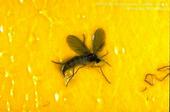![Figure 1. Bed bug adults (bottom, darker red) and nymphs. All life stages and both sexes of bed bugs preferentially feed on human blood. [Photo courtesy of Dong-Hwan Choe, UC Riverside.]](https://ucanr.edu/blogs/UCIPMurbanpests/blogfiles/25055small.jpg)
[From the December 2012 issue of the UC IPM Retail Nursery & Garden Center News]
After decades of relative obscurity, bed bugs (Figure 1) are exhibiting a global resurgence. In the United States, the Northeast and Midwest regions have been considered bed bug hot spots, with the highest reported incidence, but California has recently experienced a multitude of bed bug reports, with Sacramento experiencing the largest increase in requests for bed bug management services in the country in 2013. Causes for this resurgence may include increased global traffic and commerce, insecticide...
![Western drywood termites. [Photo by R. Tabuchi]](https://ucanr.edu/blogs/UCIPMurbanpests/blogfiles/24793small.jpg)
After the subterranean termite, the western drywood termite, Incisitermes minor, is California's second most important termite pest.
Drywood termites are difficult to detect. They live deep inside wood and except during periods when they swarm or when repair work is being done on infested homes, they are seldom seen. The most common sighting of drywood termites is when flying adults (or “swarmers”) are seen during daytime hours in summer and fall. Dampwood termites also can swarm during summer and fall, but they can be differentiated from the western drywood termite based on their larger size and attraction to lights at dark.
Because of the difficulty in detecting drywood termites and determining the...
![Greedy scale colony. [Photo by J.K. Clark]](https://ucanr.edu/blogs/UCIPMurbanpests/blogfiles/24497small.jpg)
People sometimes don't recognize scales as insects, but understanding scale types and signs of their presence will enable you to best manage them if encountered on your plants.
Scale insects are circular, elongate, or oval insects that often resemble discolored or raised areas on bark, leaves, or fruit. Scales are small and mostly immobile and damage many types of trees and shrubs by sucking out plant juices with their tiny, strawlike mouthparts. Infestations can cause yellowing or premature dropping of leaves, sticky honeydew, and blackish sooty mold. Plant parts can distort or die back, depending on the species and abundance of scales.
Although most plants...
![Whitish wax and sticky honeydew from Asian woolly hackberry aphid on hackberry leaves. [Photo by J.K. Clark]](https://ucanr.edu/blogs/UCIPMurbanpests/blogfiles/24066small.jpg)
The hackberry woolly aphid (Shivaphis celti), sometimes called Asian woolly hackberry aphid, infests the widely planted Chinese hackberry (Celtis sinensis) and other Celtis species. Often, the first observed sign of a hackberry woolly aphid infestation is the sticky honeydew it produces, upon which blackish sooty mold grows, creating a sticky mess on leaves and surfaces beneath infested trees.
These aphids also secrete pale wax, which covers their bodies. Woolly aphids on shoot terminals and leaves appear as fuzzy, bluish or white masses, each about 1/10 inch or less in diameter. Winged forms have distinct black borders along the forewing veins and their antennae have alternating dark and light...
- Author: James A. Bethke
- Author: Mary Louise Flint

[From the July 2014 issue of the UC IPM Retail Nursery & Garden Center News]
Fungus gnats are small flies that infest soil, potting mix, or plants grown in pots or containers (Figure 1). Your customers may complain about fungus gnats resting on or swarming around plants or soil or flying around windows in their houses.
Adult fungus gnats don't harm plants or people, but they can be annoying. On the other hand, fungus gnat larvae (Figure 2), which live in soil and feed on roots, can be damaging when their numbers are very high, sometimes causing plants to wilt. Their feeding...


